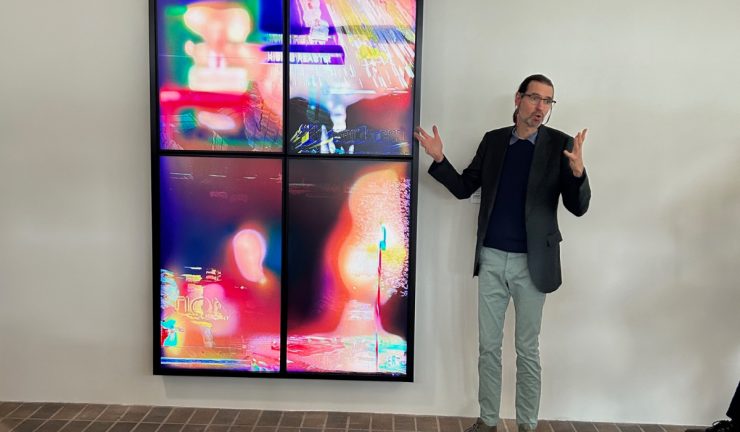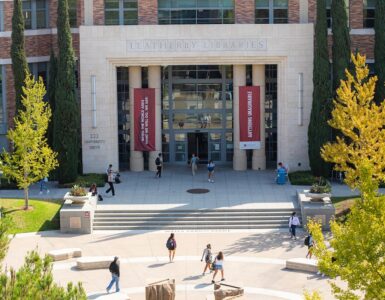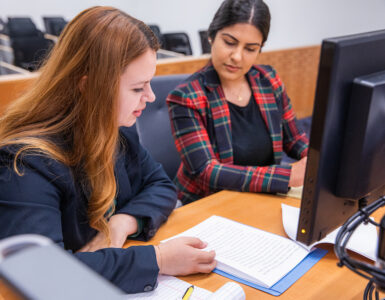On April 13, the Phyllis and Ross Escalette Permanent Collection of Art in Wilkinson College of Arts, Humanities, and Social Sciences unveiled its newest artwork installation, “Pareidolia,” by internationally renowned multimedia artist Daniel Canogar.
The artwork, which is displayed in the lobby of the Becket Building, was commissioned thanks to a grant from the National Endowment for the Arts and matching gifts from Escalette donors.
“Pareidolia” consists of four large display screens streaming an constantly-changing digital collage of colors, images and text. It’s not a video loop that continuously repeats, but a self-generating artwork that continuously updates and reinvents itself.
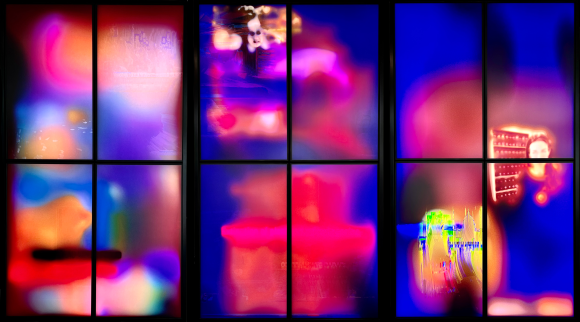
“I think this is one of the most aligned media of the moment because everything is so algorithmic right now,” said Canogar, who admitted that he is himself addicted to the news. “We’re so driven and influenced by algorithms right now and particularly what we consume on media and social media feeds – this is trying to make sense of it through art.”
Every day, a computer housed in a back room of the Becket Building downloads about 600 videos from over a dozen cable news channels that run the gamut of political affinities. Those videos are matched with data from the Chapman University Survey of American Fears, an ongoing study in Wilkinson College of Art, Humanities, and Social Sciences.
Because the news changes constantly, the result is random and unpredictable, giving the project a life of its own.
“I always say that generative algorithmic art is almost like a performance,” Canogar said. “I have set the stage for this artwork, and setting that stage has hundreds and hundreds of rules, like a very composed artwork, but those rules are allowed to manifest and change constantly.”
Multimedia Projections Illuminate American Fears
Though it is a thoroughly 21st century work of art, Canogar’s work has roots in the 18th and 19th centuries, particularly in the work of Étienne-Gaspard “Robertson” Robert, whose 1797 Phantasmagoria used “magic lanterns” to project ghostly specters to audiences in post-revolutionary Paris.
“It was a way for the public to process the fear and trauma of the French Revolution,” Canogar said, about how he tried to bring this aesthetic into “Pareidolia.” “I wanted to create this window into our inner world, those fears that are tormenting us, that are floating around, that are very haunting but very beautiful at the same time.”
“It’s been almost therapeutic to create this artwork, to try and understand a little better about how there’s a lot of fearmongering going out in the media,” he said. “’The media is really one of the biggest sources of generating fear and a way of controlling us. We need to figure out a way of exorcising this and shedding it.”
Chapman’s “Team Fear” – led by Christopher Bader, chair of the department of sociology, Ann Gordon, associate professor of political science, and Edward Day, associate professor of sociology – agrees that American fears seem to be on the rise, an impression backed up by survey data. Now in its ninth year, the annual fear survey tracks the worries and concerns of Americans and tracks trends over time. In the most recent survey, the list was topped by fears of political corruption, illness and the threat of nuclear attack from Russia.
“The goal of doing this year after year is finding out why this happens to us, why we’re so easily made to fear things, the negative consequences that has on us, and how we can turn that around,” said Day, Ph.D.
“What makes fear interesting is the emotion, not the intellectual side of it,” said Day, who was excited to see fear survey results visualized in such a dynamic way. “We get an immediacy that you don’t get [from the stats]. Here … he’s pulling the terms from the survey and finding them out there in the news – and the immediate emotional impact of the fear, as well – in a way that we simply can’t do as scientists, and that makes it exciting for us.”
“This project is a wonderful example of interdisciplinarity at its very best. It’s a work that pulls together data visualization, programming, social science and graphic art,” said Jennifer D. Keene, dean of Wilkinson College. “This is a great example of joining art and social sciences to create new understandings, new ways of thinking.”
Promoting Academic Excellence Through Art
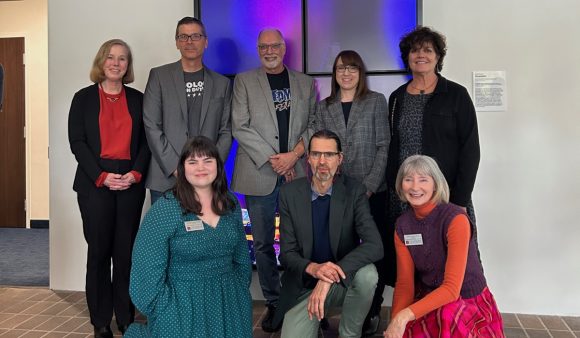
“Pareidolia” is the biggest project undertaken by the Escalette Collection, Chapman’s “museum without walls,” Established in 2010, the museum maintains a growing collection of modern and contemporary art that is displayed in public spaces throughout the university’s campuses. The artwork’s location in the lobby of the Becket Building, a modernist building constructed in 1954 that’s located on Palm Avenue, means that it is easily accessible to the wider community.
“We’re so happy to have this space at the intersection of Chapman and the Orange community so that we can share this work widely with everyone,” said Fiona Shen, the Escalette director.
The grant that funded the installation was the first NEA grant awarded to the Escalette.
“The grant marks the stature of Chapman University as a champion and steward of contemporary art in Southern California,” said Provost Norma Bouchard. “Artworks such as “Pareidolia” keep Chapman in the public eye as a promoter of academic excellence through engagement with contemporary art.”
